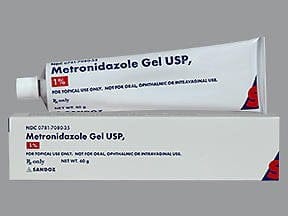Shipping with this method takes 3-5 days
Flagyl Vaginal Cream 10% + App
$54.99
Secure Encrypted Payments
Flagyl Vaginal Cream is a topical medication used to treat bacterial infections in the vagina. It contains the active ingredient metronidazole, which is an antibiotic effective against anaerobic bacteria and certain parasites.
Benefits
Flagyl Vaginal Cream is effective in treating bacterial infections of the vagina, helping to alleviate symptoms such as discharge, odor, and discomfort. It targets the bacteria causing the infection, promoting healing and restoring normal vaginal flora.
How to Use
Apply Flagyl Vaginal Cream as directed by your healthcare provider. Typically, it is applied using an applicator, which is inserted into the vagina. Follow the instructions provided with the medication for the correct dosage and duration of treatment.
Possible Side Effects
- Vaginal irritation or itching
- Unusual discharge
- Metallic taste in the mouth
- Nausea or stomach upset
If you experience severe side effects or signs of an allergic reaction, such as hives or difficulty breathing, seek medical attention immediately.
Warnings and Precautions
Do not use Flagyl Vaginal Cream if you are allergic to metronidazole or any other ingredients in the cream. Inform your doctor if you are pregnant, planning to become pregnant, or breastfeeding. Avoid alcohol consumption during treatment and for at least 48 hours after completing the course, as it may cause adverse reactions.
Storage
Store Flagyl Vaginal Cream at room temperature, away from light and moisture. Keep it out of reach of children and pets. Do not use the cream after the expiration date on the packaging.
Additional Information
Flagyl Vaginal Cream is available at YouDrugStore. Consult your healthcare provider for more information on its use and to determine if it is the right treatment for your condition.
Express Shipping - from $25.00
Prices:
- Dry-Packed Products $25.00
- Cold-Packed Products $35.00
Shipping Countries:
- United States (all contiguous states**)
- Worldwide (excludes some countries***)
Standard Shipping - $15.00
Shipping with this method takes 5-10 days
Prices:
- Dry-Packed Products $15.00
- Not available for Cold-Packed products
Shipping Countries:
- United States (all contiguous states**)
- Worldwide (excludes some countries***)
Do I need a prescription to order medication from YouDrugstore?
If you wish to order prescription medication from YouDrugstore, yes you do need a valid prescription issued by your local doctor. You do not need a prescription to order over-the-counter health products marked as non-prescription or over-the-counter on our website.
How do I order prescription medication from YouDrugstore?
We make it easy to order prescriptions from YouDrugstore.com any time, 24 hours a day, 7 days a week. Simply search the website and select items to add to your shopping cart. When you check out, send us your original prescription for all prescription drugs. After receiving your order and prescription, our team of pharmacists, technicians, and physicians must review them before we can ship your package. We will not charge your credit card or process your payment until your prescription is approved.
For more information on how to order prescription medication from YouDrugstore, view our How To Order page.
How much does shipping cost when I order from YouDrugstore?
When your order is more than $100, shipping is completely free. For orders less than $100, you just pay a $15 flat-rate shipping fee for your entire order. YouDrugstore.com also sells a wide variety of over-the-counter health products if you want to order more to spend $100 and get free shipping. You can learn more by reading our Shipping and Returns Policy.
When will I receive my YouDrugstore order?
Most orders reach their destination within 7 to 10 days. However, please allow up to 21 days after we ship your order to allow it to reach your home address. Please note that we can only ship your order after we have received your payment and an original copy of your prescription.
Will the pills or packaging be different when I order from YouDrugstore?
If you usually take a brand name pill and have instead ordered a generic drug, your pills may look different. Although they may look different, generic versions of a drug have the same active ingredients and work in exactly the same way as the brand-name medication. The appearance of medication or packaging may also differ from country to country, even though the strength is the same. For example, Celexa 20MG is usually a peach-colored pill, but in Canada it is white and slightly smaller, even though the same company manufactures both pills. Two different brands of generic medication may also look different because they are made by different manufacturers, although they are equivalent in every other way.
How does medication from Canada differ from medication in other regions of the world?
Canada has high standards and regulations governing the manufacturing of medication and health products and the licensing of doctors and pharmacists. Despite some possible cosmetic differences, medication from Canada is the same quality and strength as medication from other areas like the United States.
Why are prices on YouDrugstore different from prices at other pharmacies?
Unlike some regions of the world, Canadian medication prices are regulated with limits on how much patients have to pay for their prescriptions. This means that Canadian drug costs are often lower than other regions.
Is it safe to place my order online?
YouDrugstore runs a daily McAfee security scan to check for any potential vulnerabilities on our website, which ensures our servers and software are always up to the highest standards of online safety. We also use 256bit encryption to transfer all sensitive information through our website, including your payment information and contact information, with an SSL certificate from GeoTrust.
Where can I find YouDrugstore's policies on returns, privacy, and security?
If you want to know more about YouDrugstore’s Privacy Policy, Return Policy, and Security Policy, you can read them at:

